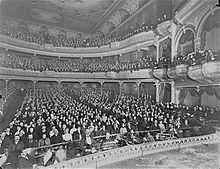Opened 9 January 1868 | ||
 | ||
Similar Proctor's Theater, London Terrace, Niblo's Garden, Hotel Chelsea, Chelsea Piers | ||
Pike's Opera House, later renamed the Grand Opera House, was a theater in New York City on the northwest corner of 8th Avenue and 23rd Street, in the Chelsea neighborhood of Manhattan. It was constructed in 1868, at a cost of a million dollars, for distiller and entrepreneur Samuel N. Pike (1822–1872) of Cincinnati. The building survived in altered form until 1960 as an RKO movie theater, after which it was replaced by part of an urban renewal housing development.:599
Contents
History
Pike's Opera House was built on what had been the property of Clement Clarke Moore, whose home, "Chelsea", has given its name to the neighborhood. The architect was Griffith Thomas. The grand auditorium was seventy feet from parquet to dome, with six proscenium boxes and two tiers. It could accommodate 1800 people, but over 3500 were known to have gained admittance at some popular performances. The first performance, on January 9, 1868, was Il trovatore, after which seven operettas by Jacques Offenbach were given in the space of four months. But the theater lost money initially, owing in part to competition from the Academy of Music on 14th Street.:599
Fisk and the Grand Opera House
Jim Fisk and Jay Gould bought Pike's theater in January 1869 and renamed it the Grand Opera House. Fisk extended the repertory to include more operetta—Offenbach's La Périchole had already received its American premiere there, 4 January 1869—and plays, like Victorien Sardou's La Patrie, expressly translated for the theater. Vehicles for his mistress Josie Mansfield are often reported, though her name does not appear in the detailed cast lists in Brown; her house west of the theater on 23rd Street was connected to the theater, it was reported, by a subterranean tunnel.
Fisk's murder
At the time when Fisk and Gould's failed attempt to corner the market in gold resulted in "Black Friday", September 1869, Fisk barricaded himself in his second-floor premises at the opera house, which served as headquarters for his Erie Railway. When he was shot by his partner, Edward S. Stokes, Fisk's body lay in state in the grand lobby.
Poole and Donnelly
In 1876, when the authorities began cracking down on theatre fire safety, the Grand Opera House was the only theatre to pass inspection.
A rapid series of managers were unable to make the house a financial success, its overhead swallowing profit. "The house was considered, in theatrical parlance, a 'Jonah', and it was almost impossible to find any respectable manager who would take it," according to Brown. When John Poole and Thomas Lester Donnelly rented it in 1876, it was with the proviso that "a small percentage of the profits should go to the Erie Railway company". The new management lowered the price of admission and catered to the popular tastes of New York's "west side": Uncle Tom's Cabin (in blackface) and Buffalo Bill were among the first season's attractions; theatrical productions were accompanied by "specialty acts".:614
RKO cinema
For its conversion to the second RKO 23rd Street Theater, Thomas W. Lamb Associates converted it in modern style. It opened 4 August 1938 with a double bill of Having a Wonderful Time and Sky Giant. It closed for demolition, 15 June 1960 and was gutted by fire 29 June.
